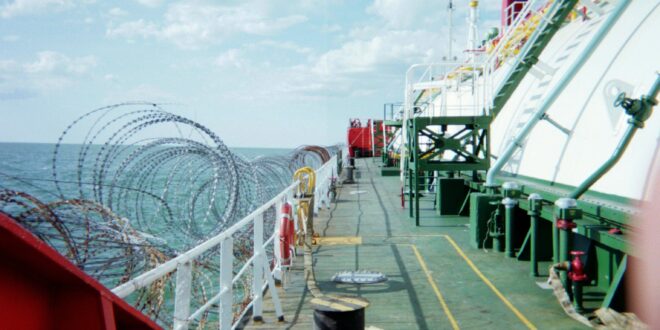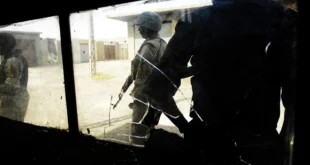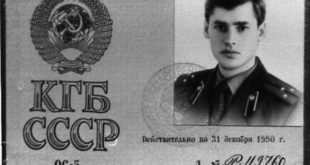by Martin Kufus
Somali piracy already was waning in 2012 when I arrived on the Indian Ocean as a member of a four-man rifle team guarding a client’s cargo ship against hijack. It was my first time aboard an ocean-going vessel. This one was an Asian-flagged liquefied petroleum gas (LPG) carrier hauling, at full load, about 5.8-million pounds of propane and butane in two large tanks on the main deck. Its potential as a “floating bomb” was real.
A decrease in this organized criminal activity, which had radiated out from the Horn of Africa, did not mean Somali piracy no longer was a viable threat in a very busy region for global maritime commerce. It simply meant the odds of a hostile approach toward any merchantman in the internationally declared “High Risk Area” (HRA) for piracy on the Indian Ocean were not as high as before. I pegged it as 1 out of 10.
READ MORE from Martin Kufus: ‘G is For Gonzo’: A Slice From an Editor’s Life at Soldier of Fortune
In the years immediately after the 2009 hijack of the unprotected American-flagged cargo ship Maersk Alabama (an event that would inspire the 2013 movie “Captain Phillips”) commercial shipping mostly relented in its bias against armed guards aboard nonmilitary vessels.
It was one of the few times my peacetime US Army duty and Honorable Discharge carried civilian weight. Contracted maritime security in the HRA was not for everybody—there were far too many risks and liabilities for a company to hire someone simply because the guy liked guns and wanted to shoot bad guys. Generally speaking, operational personnel either were ex-military or ex-law enforcement with good service records. They had to have small-arms skill, firearms discipline and safety, the ability to follow instructions and function under stress, a “team player” mindset, and a polite, professional demeanor so as to get along with the client ship’s crew.
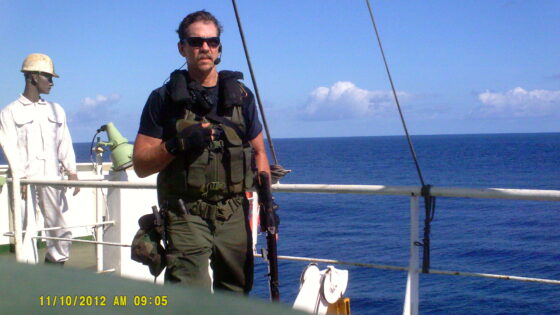
(photos courtesy of Martin Kufus).
Another step toward my qualification for deployment was a self-paid battery of shots as prophylaxis against diseases I might encounter in Africa or the Middle East. Lastly, I scraped the bottom of the money barrel for $900 tuition (plus meals and cheap motel room) for a five-day class in port city Houston toward “Standards of Training, Certification and Watchkeeping–95” certification, a basic maritime credential.
On my last pre-deployment visit to security contractor Espada’s offices in San Antonio, I gathered a large duffel-bag/rucksack with company-issued gear. The support staff had booked my airline travel from Texas to Europe to the Middle East to Mauritius, a French-speaking island nation about 550 miles east of Madagascar. There, our security team members would link up and wait to rendezvous with the ship.
Sometimes the weather on the Indian Ocean was sunny-hot and calm; sometimes it was not. On this particular day, the dark-blue ocean was restless northwest of Madagascar. Endless whitecaps churned out to the horizon in all directions. The waves could hide from view the approach of motorboats too small for early detection by our ship’s radar. The 340-foot cargo vessel pushed along at a steady 12 nautical miles per hour (almost 14 mph). It slowly rolled back and forth, 5–10 degrees off level, in the restless water.
“Jefe, this is Beetlejuice,” I radioed. “Comms check.” Releasing the Motorola’s transmit button, I waited for my team leader (call sign El Jefe: the boss) to reply from his tiny cabin one deck below. It was 9 a.m., the start of my three-hour daywatch in our security team’s 24-hour coverage. Day 60 on the ship.
My duty station was outdoors on the navigation/bridge deck. Typically, I spent a few minutes on the port (left side) “wing”; then, walked to the rear of the deck and stood by the sand-bag firing positions, watching the horizon astern; then, moved to the starboard wing. The doorway to the wheel house was a few paces away. Inside the not-new ship’s automated command center the duty officer, Eric, a 30-something Filipino, attended to his navigational and record-keeping tasks. (All of this ship’s officers were from the Philippines.)
Below me, on the main deck, a few of the crewmen performed their morning work. The professional seamen were from the West African countries of Ghana and Sierra Leone. They wore hardhats, white or orange coveralls, and steel-toed boots. The men paid little obvious attention to the coils of rusted but razor-sharp concertina wire that stretched almost fully bow to stern along the port and starboard handrails. They stepped over the pre-connected fire hoses (whose nozzles were open and lashed to railing, pointing outward and down) that stretched across the main deck.
READ MORE from Martin Kufus: A Visit to the Real Life A-Bomb Site Depicted in Oppenheimer Film
I glanced at my wristwatch. The date was “10-31”: Halloween back in America—goblins, ghouls, trick-or-treat. Out here in the HRA there were real bogeymen in the form of skinny, desperate thugs with Soviet/Russian-made Kalashnikov automatic rifles, PKM light machine guns, and rocket-propelled grenade (RPG) launchers. The pirates lived aboard crowded “mother ships” adrift in the shipping lanes or hiding around small islands, avoiding naval frigates and coastal-patrol boats, waiting to ambush undefended merchant vessels and hijack them for (they hoped) multimillion-dollar ransoms. Their attack skiffs, 20- to 25-foot motorboats, carried narrow ladders with hooks on the top for boarding cargo vessels—like ours. The skiffs usually carried three to six pirates apiece.
“Beetlejuice, I hear you loud and clear,” the TL radioed back after a few seconds. He was an ex-policeman from Del Rio, Texas, and a former homeland-security contractor. “Hear you Lima-Charlie,” I replied. “Beetlejuice—out.” I had not come up with that radio call-sign for myself; rather, some comedian back at Espada apparently spent too much time as a child watching silly movies like the dark comedy “Beetlejuice.”
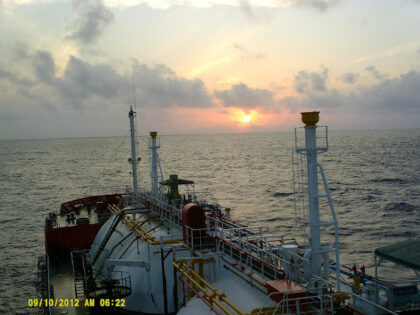
Sunrise on the Indian Ocean aboard the LPG carrier.
A few days earlier we had left the harbor at Mombasa, Kenya, after waiting weeks there to unload LPG cargo when all parties had agreed on a price. That our ship had been anchored in a secure harbor, away from piracy—Mombasa’s port police as a courtesy relieved us of our rifles and ammunition for the duration of our anchorage—did not mean there were no security concerns: We pulled shifts at night in case petty thieves in small boats tried to pull alongside our ship to try to come aboard and steal or rob. (I had the midnight shift and made sure I pointed my high-beam tactical flashlight at any small craft that came near.) So, as we sailed away from the busy port in early afternoon, our four-man security team was conspicuously posted on the ship’s superstructure. Jefe wanted the Mombasa harbor spies to see us and phone or e-mail Mogadishu, Somalia, that this ship had security guards.
There were at least 200 maritime-security (“Marsec”) companies worldwide. The competition for international shipping-industry clients was fierce. More than half of the Marsec companies were British; their shipboard operators, reputedly, were mostly veterans of the Royal Marines or Special Air Service. Depending on whose figures you believed, fewer than half of the hundreds of merchant ships making the thousands of transits each year on the Indian Ocean employed armed security guards. It was from this undefended majority of vessels the Somali pirates wanted to take their prey. Some of these merchant ships, however, were so big the skiff-borne pirates could not intimidate the captain and crew with bullets or RPGs, nor could they climb high enough to scramble aboard—the colossal RORO (“roll-on, roll-off”) vehicle-transport ships come to mind.
Pirate recruits reportedly received training at secret camps in Somalia. However, they were not military personnel steeled to the possibility of combat casualties. In the early days, the brutal business of Somali piracy initially was confined to the waters immediately around the Horn of Africa. Foreigners helped create this scourge.
“The collapse of the Somali state in 1991 and the ensuing civil war meant that there were no official authorities to maintain the country’s sovereignty,” the 2012 book Coping With Capture, published by the Danish Maritime Officers, stated. “Foreign vessels exploited the power vacuum by fishing illegally and by dumping toxic waste along the Somali coastline. The original Somali pirates were groups of armed locals who ventured out to intercept and lay claim to the cargo (and other valuables) belonging to the foreign vessels. The groups adopted official-sounding names, such as National Volunteer Coast Guard, and used their self-proclaimed authority to hail and capture foreign vessels, which were often cargo ships unconnected with illegal fishing.”

The criminal enterprise flourished. The Somali-piracy confederation eventually took the quantum leap of hijacking fishing trawlers and dhows, sometimes keeping crews as hostage labor, and converting the stolen vessels to floating operational bases. These mother ships and their skiffs—the NATO term for an operational unit was Pirate Attack Group (PAG)—began to range widely into the southern Red Sea (an area also worked by pirates from the Sudan, Yemen, and Eritrea), Gulf of Aden, Arabian Sea, Gulf of Oman, and Mozambique Channel, and across the Indian Ocean.
In 2011, Somali pirates hijacked 28 merchant vessels in 237 attacks, according to maritime-industry statistics. Ransoms for the ships and multinational crews totaled at least $135 million. By 2011’s end, pirate gangs reportedly held a total of 1,026 hostages, a few of whom had been in captivity for more than two years.
Their documented mistreatment of hostage mariners, most of whom were from countries like the Philippines, China, Thailand, India, and Kenya was harsh at best and lethal at worst. Rarely were American or British seamen involved, though, so this awful situation received little news coverage in the United States. One exception, of course, was the hijack of the Maersk Alabama, the American container ship sailing to Mombasa. Navy SEAL snipers killed the three pirates holding the ship’s captain at gunpoint aboard an enclosed, motorized lifeboat and freed the mariner.
Pirate captivity aboard ship or on land in Somalia typically lasted months. Malnutrition, dehydration, and humiliation were among the least of the survival challenges faced by merchant mariners. And if pirate leaders’ long-distance ransom negotiations with ships’ foreign owners and maritime-insurance corporations bogged down, the onboard occupiers could become downright sadistic toward their helpless captives—especially if the pirates ran out of their narcotic chew, the African weed khat.
Marsec statistics showed that no merchant ship in the HRA ever had been hijacked that had privately contracted, armed security personnel aboard—a fact grudgingly acknowledged by UN, European Union, and NATO officials.
We test-fired our weapons off the poop deck during our first afternoon on the ship. Yellow balloons drifting in the big propeller’s wake were our targets. Some of the crewmen watched, fascinated, from two decks above. I squeezed off 16 rounds of 5.56-mm ammunition altogether and adjusted the rifle’s iron sights to 300 meters.
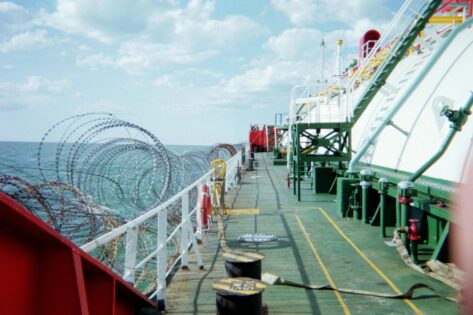
Several of the crewmen indeed told me they felt better having armed guards aboard. One of the “ABs” (able-bodied seaman) said he had been on another ship about three years earlier, in transit to Egypt from Malaysia, and watched a hijack. In the Gulf of Aden his cargo ship joined a convoy being formed under escort by two naval vessels, one in front and one in the rear. Motorboats suddenly appeared, he recalled, and sped in between the big ships. The naval forces could not react fast enough. The pirates boarded a merchant ship in the middle of the formation. “Once they’re on board, it’s too late,” the AB, from Sierra Leone, said.
The international anti-piracy coalition had gotten much better at intercepting the PAGs. I saw some of this international naval muscle during our various transits: the German frigate Sachsen docked in Mombasa; the French frigate Dupleix docked in the Seychelles; and the Indian frigate Delhi underway toward Kenya.
So, over my dead body—literally—and those of my teammates would this ship and crew become a 2012 hijack statistic. It would not be a soft target for capture by gunmen from the failed state that brought us “Black Hawk Down.” A Chinese-made, Kalashnikov-style rifle (rented from a foreign contractor), its curved magazine holding 30 rounds, hung comfortably from my left shoulder. While I was on duty, the weapon never left my side—a habit drilled into my head half a lifetime ago in Army Ranger school.
My OD-green tactical vest carried more ammunition magazines, a scabbard knife, and ocean-survival gear. My German-made Kevlar helmet sat nearby. Our team’s medical trauma bag was parked in a corner of the wheel house, along with extra ammunition. If I spotted incoming attack skiffs, all I had to do was push the radio’s emergency button and then say “Pirates” three times—not “Beetlejuice”—and Jefe and team members Fernando and Karu (ex-infantrymen from the Philippines and Sri Lanka, respectively) would join me in less than a minute.
Merchant ships vulnerable to pirate hijack by then had below-deck refuges called “safe rooms” or “citadels.” Depending on the ship’s pirate-attack plan (with or without armed guards), alarms sounded, horns blared, and crewmen assembled in the citadel—often, proximate with the engine room—and waited for the officers to join them. The captain and duty officer (probably, by now, wearing Kevlar helmets and body armor) would radio distress calls to HRA naval-security centers, put the ship on auto pilot, and evacuate the wheel house. Or, they might stay at the helm, putting the ship in a zigzag maneuver that, although slower than a straight-line course, would generate large wakes to impede pirates’ boarding attempts. If the officers and crewmen locked themselves in the citadel, alternate controls there would thwart the pirates, who would make a beeline for the wheel house but likely did not know how to pilot a big ship.
READ MORE from Martin Kufus: At Fort Bragg, We Trained Under Special Forces Legend Nick Rowe
During my first daywatch in our first transit, the Captain called a wheel-house meeting for the crew. (This was his first assignment as ship’s master, I had heard.) He read a checklist of worst-case actions to be taken just before pirates boarded the ship. At some point, he said, “our friends” on the security team would join the crew in the citadel. I discreetly shook my head No. The Captain didn’t see me, but most of the crewmen noticed. In a few minutes, El Jefe tactfully corrected the Captain’s well-intentioned error.
“We won’t be joining you in the citadel,” he calmly told the wheel-house gathering. “Our job is to protect the crew”—he pointed at all of the men, for effect—“then the ship, and next, its cargo. My team will fight to the death.” Jefe turned to the Captain. “Do not slow down, Sir. Do not be intimidated by the pirates—even if they shoot at the wheel house. Do not stop the ship,” the TL concluded. The Captain nodded.
Marsec was not a job for the trigger-happy or impatient. Throughout the HRA, legitimate fishermen used skiffs with large outboard motors. Fishermen also packed Kalashnikov rifles—to protect their own boats against pirates. Fishermen might steer their skiffs toward a merchant ship—to try to make the large vessel change course and not run over unseen fishing nets or lines ahead. Fishermen, however, did not carry RPG-7s, belt-fed machine guns, and long ladders or climbing poles. They also did not “swarm” a cargo ship with several motorboats.
A merchantman’s lookout, whether crewman or security guard, could ideally see an incoming skiff at a range of several miles. (There never had been a confirmed, nighttime attack in the HRA. Nonetheless, many ships ran with only navigational lights on at night, keeping windows and external doors cloaked.) The ship’s X- or S-band radar already might have detected the small boat and its wake farther out than that; an aluminum hull reflected radar waves much better than wood or fiberglass.
By the time a skiff was about 500 meters away, observers would have binoculars trained on it, looking for telltale ladders and multiple weapons. The Marsec team could try to “wave away” the suspicious boat. If that didn’t work, the TL or designated sharpshooter would fire warning shots to the left or right of the boat. Of course, if the skiff’s occupants opened fire at the ship at any time, restraint ceased. Given the predictable catastrophe of an RPG penetrating one of our ship’s large cargo tanks and detonating, say, several million pounds of compressed LPG, our team’s rules of engagement were especially conservative.
El Jefe was on two Espada jobs in which shots were fired. Both occurred in 2011. In one incident, the team was guarding a bulk-carrier vessel in the Arabian Sea near Oman. A single skiff with up to a half-dozen pirates carrying AK-47 or AKMS rifles attempted to intercept the big ship, which was hauling grain or fertilizer. In the other incident, the team was guarding a hazardous-material carrier coming from Oman. Two skiffs with rifle-armed pirates approached the ship “in the middle of the Indian Ocean,” he said. In both incidents warning shots chased away the pirates, Jefe recalled, but “it was kinda at the point if they didn’t turn around, we’d start putting rounds into the skiffs.”
On this job, however, the TL did not have to fire any warning shots. My ammunition expenditure held at 16 rounds (in test fire of my rifle). Pirates did not come around our ship; they were somewhere else in the HRA. That our ship’s transits between Mauritius and Kenya and back were uneventful was just fine with the captain and crew. And if they were happy, so were we.
The above is an excerpt from Plow the Dirt but Watch the Sky, by Martin Kufus, a former editor at Soldier of Fortune.
 Soldier of Fortune Magazine The Journal of Professional Adventurers
Soldier of Fortune Magazine The Journal of Professional Adventurers


